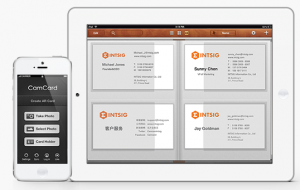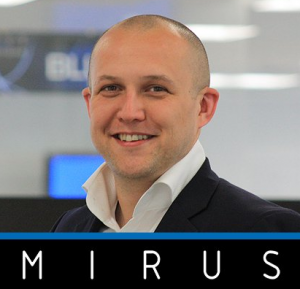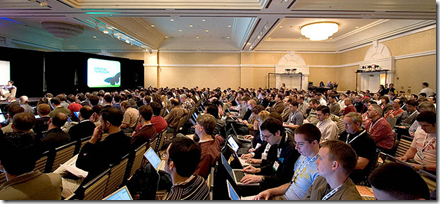Richard Tubb's Blog, page 90
May 18, 2014
3 Ways to Succeed At Networking Before Attending The Event
 The most common question I hear when working with IT businesses is “How do I find new clients?”. The answer I always give to them in the first instance is a simple one – get out there and meet fellow businesses by attending networking events.
The most common question I hear when working with IT businesses is “How do I find new clients?”. The answer I always give to them in the first instance is a simple one – get out there and meet fellow businesses by attending networking events.
The old adage “People do business with people they like” is as true now as it has ever been, and so attending networking events where you can meet new people, build new relationships and strengthen existing relationships is very important and should be an integral part of any IT Solution Provider or Managed Service Providers (MSP) plans.
But… Networking Doesn’t Work For Us
But the push-back I often get from the IT businesses I share this advice with is “We’ve tried networking, and it doesn’t work for us”. “We meet the wrong people”, “It’s a waste of my time”, “I’ve nothing in common with the people I meet” are all common complaints I hear about networking events.
I understand this attitude because I’ve been there myself. Dragging myself up at the crack of dawn to attend a networking breakfast which feels like a waste of time, or pushing myself to attend the latest Chamber meeting where people seem more interested in talking about their Sports teams than business.
But attending networking events does work. You can meet the right people who you can do business with – either directly or indrectly. And these events don’t have to be a chore.
Here’s my 3 ways to succeed at networking before attending the event.
Choose the right event
Choosing the right networking event to go to is key. But how will you know the right event to attend? By asking your contacts!
Rather than randomly signing up for an event you’ve found via Google, why not ask your clients, your strategic alliance partners and other business owners near to you which events they attend? More often than not they’ll point you in the right direction or even invite you to join them at the next event they are attending – which has the bonus of meaning they can introduce you to others when you are there.
While there’s no guarantee that the events others recommend to you will be an ideal fit for you, experience tells me that a recommendation from others is a much better way to choose where and when to spend your time than any other way of picking an event.
Check out the attendee list prior to the meeting
I’m still surprised by the number of attendees at networking events who don’t bother to do research to find out who else is attending the same event.
Most progressive networking events – especially members events – publish an attendee list prior to the event to allow others to see who is attending. You can scan this list and do some research on your fellow attendees, understanding the people in the room you think would be best to meet and then seeking them out at the event itself.
Knowing who you want to meet and why is preferable to turning up at the event and hoping that you bump into somebody who you have something in common with!
Even if the attendee list isn’t published prior to the event, when you arrive at the event there is often an attendee list you can scan, or you can ask the event organiser if you can check who is attending. Most will be happy to share.
Finally, it’s worth remembering that many people announce their attendance at events on Social Media prior to the event. Check out LinkedIn groups and run Twitter searches for keywords related to your networking event to see if you can find other attendees, and then seek them out on the day itself. Which leads us nicely to my final tip…
Announce you’re attending the event on Social Media
I can’t tell you the number of networking events I’ve attended where I’ve announced I’m attending the event on my Social media feeds – such as LinkedIn, Twitter and Facebook – and somebody at the event has sought me out to say hello to because they knew I was attending.
I’ve even (flatteringly) had people tell me they’d decided to attend events because they saw I was going, and so decided to come along too!
By announcing you’re intention to visit the event on Social Media, you’re doing two things – giving the event a plug to ensure that more people are aware of it, and giving others the opportunity to seek you out at the event itself.
Conclusion
Networking events are still a sure-fire way to build relationships and win business – but only if you choose the right networking events, do your preparation before hand and use Social Media to link up with others.
People do business with people they like. Make sure people have a chance to meet and like you!



May 2, 2014
Slingr – Buy someone a drink from anywhere in the world!
 Every Friday I try to share one of my favourite finds of the week – a web-site, tool or app that has impressed me.
Every Friday I try to share one of my favourite finds of the week – a web-site, tool or app that has impressed me.
My Friday Favourite this week is Slingr – a location-based social gifting app that allows you to remotely buy a beer (or indeed, any food or drink on offer at a location) for somebody, wherever you are in the world!
Location-based Social Gifting
Available as an App for iOS and Android, Slingr works by allowing registered users to check-in to a location such as a bar or restaurant – in the same way you might check-in on Facebook, Foursquare or Yelp!
Once checked in, Slingr updates your Social Media status (at the moment, Facebook, Twitter and LinkedIn are all supported) to let your network know which location you are visiting, along with a link.
Any of your network who follows the link can see a choice of food and drinks the venue has on offer, and can choose to buy you something from wherever they are, that order then being delivered to your table along with a printed note featuring a message from the buyer.
Which Locations support Slingr?
 At the moment, Slingr only covers some locations in San Francisco and Los Angeles – and it has plenty of competition from Gift Card apps, Coupon Apps and the big location based players such as Facebook and Foursquare. With that said, I can see huge potential for Slingr being used at Conferences, Parties and all manner of locations and events and I hope their business takes off.
At the moment, Slingr only covers some locations in San Francisco and Los Angeles – and it has plenty of competition from Gift Card apps, Coupon Apps and the big location based players such as Facebook and Foursquare. With that said, I can see huge potential for Slingr being used at Conferences, Parties and all manner of locations and events and I hope their business takes off.
Who will be the first in your area to start accepting Slingr orders? Well, if you’re a business owner you can apply to set Slingr up at your venue now.
Registering for Slingr
If you’d like to register for Slingr as a user, then you can get Slingr on the App Store or Slingr on Google Play for free now.
photo credit: StickDigital / Christopher Allen Fox via photopin cc



April 23, 2014
How your MSP can manage a very large client
 I’ve spoken with a number of Managed Service Provider (MSP) owners recently who have shared with me that a large proportion of their businesses revenue comes from a single large client.
I’ve spoken with a number of Managed Service Provider (MSP) owners recently who have shared with me that a large proportion of their businesses revenue comes from a single large client.
It’s easy to understand how this happens. While most MSP’s would prefer to have a mixture of clients to spread their risk, many MSP’s find one of their clients growing exponentially in size, the MSP being taken along for the ride with that client – supporting the client at every stage of their growth.
But it’s equally easy to see why an MSP owner would wake up one day and feel uneasy about the fact that without realising it was happening, suddenly 20% or more of their income is being generated from a single client.
The phrase “All your eggs in one basket” springs to mind.
20%+ income from a single very large client?
From the MSP’s perspective, if you’re reliant on a single client for 20%+ of your revenue (and I’ve spoken with MSP’s who have shared that they have 40%, 70% or in one cases, 90% of their revenue from a single client) then you may find the client putting unreasonable demands on your time – and generosity. After all, wouldn’t your business would struggle to survive without their benevolent custom?
Deriving a large chunk of revenue from a single client also puts the MSP at a disadvantage when it comes to chasing overdue payments, and indeed, every other aspect of the relationship. It’s a brave soul who rocks the boat when they can’t afford to lose a client.
But if you’re in a situation where 20% or more of your income comes from a single client, while there is no sense in panicking, taking immediate steps to prepare you to deal with any issues should be a priority for you.
Here’s 3 important steps you can use to begin managing a very large client straight away.
Keep lines of communication open
 Rapidly growing businesses tend to add new levels of management rapidly too. While your relationship with the Senior management team might be rock solid, what if someone new is hired who takes on responsibility for signing off your work – and they don’t know you from any other IT company in the Yellow Pages? Your track record and relationship with senior management suddenly means a lot less than it did before.
Rapidly growing businesses tend to add new levels of management rapidly too. While your relationship with the Senior management team might be rock solid, what if someone new is hired who takes on responsibility for signing off your work – and they don’t know you from any other IT company in the Yellow Pages? Your track record and relationship with senior management suddenly means a lot less than it did before.
Likewise, what if a new Financial Director takes over and decides to change payment terms from 30 days to 90 days. Will this have an effect on your income?
Keep your ear to the ground at your client. By making sure you are continuously communicating with your client – putting yourself in the middle of their operations, being aware of what is happening in their business, understanding (and often having input to) any changes in their business, you can make sure to head off any challenges as you see them. Regularly meeting with the client in person is key, with telephone calls to key client staff happening on a regular basis too.
Set Expectations
There’s an old phrase I’m fond of “Lack of planning on your part doesn’t constitute an emergency on mine”. But how many of us feel like we can’t say no to our largest client when they telephone us on a Sunday to ask us to drop everything for a project on Monday morning?
By keeping the channels of communication open, and letting your client know what is happening in your business as well as understanding what is happening in theirs, you can set expectations on what you’re capable and not capable of delivering for them.
The client may make assumptions over how you can help them. If you are involved in the conversation early on, you can help ensure those assumptions are realistic and fair to both parties.
Get Paid on Time
 As your client grows and your reliance on them for large chunks of your income grows too, late payments go from being an irritation to a cold-sweat inducing nightmare that can cause you horrible sleepless nights.
As your client grows and your reliance on them for large chunks of your income grows too, late payments go from being an irritation to a cold-sweat inducing nightmare that can cause you horrible sleepless nights.
Ensure that your relationship with the clients account department is strong, open and honest.
Make sure the key players in the accounts department at your client know who you are and why it’s important you are paid on time, every time.
Understand changing terms and conditions of payment to suppliers – as accounts team staff change, so do terms of payment. Sadly, as your client grows bigger, their attitude towards paying you on time may become worse.
And if payments suddenly start becoming late, don’t ignore the issue and continue working regardless. Raise the issue with Senior Management at your client and look to find a solution sooner rather than later.
Conclusion
It goes without saying that any business that relies on a single client for a large chunk of their revenue is inherently at risk so if your MSP business derives more than 20% of its income from a single client, then while there is no need for panic, its worth being aware of how this can affect your relationship with your client.
Take steps to manage that relationship better, starting now. Spend more time visiting the client in person. Ensure lines of communication are kept open at all levels of the clients business. Set expectations effectively so you are no put upon unfairly. And above all, make sure you are paid on time, every time.
Then, once you’re happy you’re managing that large client effectively – start to spread your risk by seeking out new clients to add to your books. Don’t stick your head in the sand and hope that the worst – your biggest client leaving you – will never happen. It probably won’t, but how would you feel if it did?
photo credit: thefost via photopin cc
photo credit: Tom Raftery via photopin cc
photo credit: Mukumbura via photopin cc



April 22, 2014
4 Steps to Effectively deal with Business Cards
 If you’re anything like me, you visit a lot of conferences, seminars and business networking events where you meet all manner of people.
If you’re anything like me, you visit a lot of conferences, seminars and business networking events where you meet all manner of people.
And if you’re anything like me (which I hope you’re not) then you have the memory span of a Goldfish and run the continuous risk of forgetting the name of that person you met just yesterday.
With that in mind, and because I’ve been asked by a number of people what my “event follow-up” routine looks like – here’s my guide on how to effectively deal with business cards.
1. Create Memory Hooks – Write on Business Cards
There’s a real danger that, however interesting the people I meet are, that by the time I’ve left an event (and sometimes before then) I’ve forgotten what their name was or what we talked about. What’s more, however interesting I thought *I* was – when I follow up with that person after the event, they may have forgotten who I am (I know, right?!).
That’s why it makes sense to create some memory hooks, for both you and them. Take a pen to these events (in fact, take a few – they make handy giveaways to win friends) and whenever you receive a business card from someone, on the back of the card make a quick handwritten note of:-
what you talked about. This is probably business, but it could equally be your shared love of a Sports team, a good book you’ve read recently, or even somebody else you mutually know.
any commitments you made. There’s no worse way to start a relationship than to casually promise something to someone, then fail to deliver. If you’ve said you’ll send over a link to a blog post on a topic you talked about, write it down. If you’ve said you’ll introduce the person to someone else, make a note of it. Then, make good on your commitment.
2. Scan the Business Card
 Don’t let those business cards gather dust on your desk. Before going to any event, I schedule time in my diary for within 48 hours of returning from the event to process the business cards I’ve collected.
Don’t let those business cards gather dust on your desk. Before going to any event, I schedule time in my diary for within 48 hours of returning from the event to process the business cards I’ve collected.
I use the fantastic tool CamCard to scan business cards and automatically input them into my contact list. CamCard is available for Android and iOS and is actually very strong at OCR (Optical Character Recognition) – and once you’ve scanned the card in, CamCard keeps a handy history of the cards you’ve scanned for when you need a reminder of who you’ve met and where.
Speaking of which, once you’ve scanned the persons contact details into your contact list – make sure to use the “Notes” section to write where you met them and the memory hooks you recorded – what you spoke about, who introduced you, etc. These are invaluable later when you can’t remember somebodies name, but can remember where you met them or what you spoke about.
3. Follow-Up
There’s no point in meeting people, pressing the flesh and exchanging business cards if you don’t follow-up effectively!
If I’ve made a strong connection with somebody, or I’ve made some commitments to them – perhaps an introduction or I’ve said I’ll send them some information – I follow-up with them via email. The email will typically remind the person where we met and what we discussed – remember they may need that memory hook too!
I typically connect with people via LinkedIn in the same way – I avoid using the boiler-plate “Let’s connect on LinkedIn” as I dislike its spammy nature, and instead I send a bespoke connection message, again reminding the person of where we met and perhaps mentioning why we should connect.
Finally, my CRM tool (Nimble CRM) or Rapportive will tell me if that person can also be found on Twitter and Google+. If they can, I often give them a shout-out on those platforms – people love to be seen connecting with people!
4. Be The Connector
 Finally, and if it’s appropriate, I look for the opportunity to connect my new contact with somebody else within my network who I think they’ll find valuable to meet.
Finally, and if it’s appropriate, I look for the opportunity to connect my new contact with somebody else within my network who I think they’ll find valuable to meet.
For instance, if somebody says they want to improve their LinkedIn profile, I’ll point them towards Michael de Groot. If they are an IT business wanting to improve their Marketing, I’ll suggest they speak with Gemma Telford. I’ve even connected somebody who wanted chewing gum removing from a pavement with someone who specialises in removing chewing gum from pavements. Remember, while you may never do business directly with the person you meet, you may be able to refer them to someone who does. In this way you place yourself at the centre of a network of people – and don’t be surprised when people try to reciprocate and return the favour.
When you go to events, listen to people. Pay attention to what they do and what they say. Sadly, it’s remarkable to do so nowadays – so you’ll stand out from the crowd when you do.
Conclusion
So there you have it – 4 steps to making sure the time you put into attending Conferences, seminars and business networking events is well spent.
It doesn’t have to take much time or effort, but by having a repeatable system in place, you can effectively deal with business cards quickly, grow your network effectively and build relationships with the people who can help you make a difference.
photo credit: bargainmoose via photopin cc
photo credit: SalFalko via photopin cc



April 3, 2014
Fount – Identify any web font you see!
 Every Friday I try to share one of my favourite finds of the week – a web-site, tool or app that has impressed me.
Every Friday I try to share one of my favourite finds of the week – a web-site, tool or app that has impressed me.
My Friday Favourite this week is Fount – a free tool that enables you to quickly identify any web font you see!
Bookmark to quickly identify web fonts
Fount can be a very useful tool for anyone involved in the design or maintenance of web pages. You may spot a font on a web page and want to quickly find out what that font is called. I also know from experience that it’s very easy to use a font in one of your own pages and then forget the name of the font in the future!
 To use Fount, visit http://fount.artequalswork.com/ and drag the Fount button to your bookmarks bar. The next time you see a font you want to identify, click the Fount bookmark and then click on the font you’d like it to identify. Simple, but powerful!
To use Fount, visit http://fount.artequalswork.com/ and drag the Fount button to your bookmarks bar. The next time you see a font you want to identify, click the Fount bookmark and then click on the font you’d like it to identify. Simple, but powerful!
Thanks to Yvonne Miaoulis of MSP Builder for the link!



April 1, 2014
How do you build a £9m Managed Service Provider business?
 A few months ago I was attending an Autotask Accelerator event in Birmingham where the owner of UK based MSP Mirus IT, Paul Tomlinson, was presenting.
A few months ago I was attending an Autotask Accelerator event in Birmingham where the owner of UK based MSP Mirus IT, Paul Tomlinson, was presenting.
Speaking openly about the hurdles he had overcome, and the tools and strategies which had worked for his business, Paul gave those other MSP’s owners in attendance an incredible insight into what it takes to build a successful Managed Service Provider business in the Small Business market.
Becoming a top employer
How successful? Well, in 2013 Mirus IT achieved a turnover of £7mn and in 2014 turnover is up £2mn to £9mn. Add to that to the fact Mirus has a level of staff retention that would make other IT businesses jealous, and that Mirus is considered one of the best employers to work for in the Milton Keynes area. So yes, very successful.
Interview with Paul Tomlinson
After the Autotask event I was struck with the fact that while those MSP’s in the room had felt the energy of Paul’s presentation, I’d love for the readers of my blog to as well. So I asked Paul whether he’d consider letting me record one of our conversations to share with my blog audience, and he kindly agreed.
Some of the topics I discuss with Paul during our interview are:-
How Paul moved away from being a techie and into becoming a business owner
The strategies Mirus IT use to retain the best staff
Revenue vs Profitability – Which is most important?
How to build trust with clients
How Paul sees the reliance on IT changing in the modern workplace
Mirus IT’s attempt to set a world record for playing Football
.. plus much more. The interview is over 30 minutes in length and is packed full of advice for any MSP looking to grow. If you want to want to jump to a specific subject, I’ve included some time-based bookmarks below. If you’d prefer to read the text of the interview instead, then a full transcript of my conversation with Paul can be found below.
Thanks to Paul for generously giving of his time and experience. I hope you find our interview as enjoyable and valuable as I did recording it with Paul. If you’d like to join me in saying thank-you to Paul, then you can help support Mirus IT as they play football for 72 hours to break the world record and raise money for The Milton Keynes Community Foundation. Find out more at the Mirus I.T. World Record page.
0:00 Introduction and who is Paul Tomlinson and Mirus IT?
1:08 How does a business owner move away from doing Technical work?
4:10 Why is building a fun company important for recruitment and growth?
6:45 What strategies can you use for staff retention?
8:37 As a business owner, what keeps Paul up of a night?
10:49 Learning how to delegate effectively
12:36 Profitability vs Revenue. Which is most important?
15:33 Is the trusted advisor role dead?
19:07 How is the reliance on IT changing?
22:38 Creating a Life/Work Balance
26:20 What’s the value in blogging for business?
30:31 Paul’s contact details
30:54 ISO 27001, Building a Cloud Infrastructure, VDI, VoIP.
Transcript of interview with Paul Tomlinson
Richard: Hi everyone. Richard Tubb here and today I’m joined by my friend Paul Tomlinson, managing director at Mirus IT, an IT consultancy based in Milton Keynes in the U.K. who provide managed services, specialist project work, online backup and disaster recovery, amongst many other services. Paul, thank you for joining me.
Paul: No problem, Richard. Thanks for having me.
Richard: Now Paul, I’ve known you for a while now and every time I speak to you your business seems to have grown. How many people have you got working at Mirus now?
Paul: There’s 78 employed as of today. I think we’ve got four starting in the next month and then we’ve got another five positions we’re recruiting for at the moment. So it’s growing quite well at the moment.
Richard: For anyone who doesn’t know Paul Tomlinson and who Mirus are, what’s your background? How did you grow Mirus to the stage it’s at now?
Paul: Some of my background is an engineer. I started working in IT when I was 16 and went to work for another company and then I think I was 23/24 when I started Mirus. I had just returned from working in Ireland for four years, for another company. A small MSP at the time and basically founded Mirus and it’s grown from there.
Richard: I know your role nowadays is actually less technically focused and more management focused but plenty of IT business owners I speak to begin their business as technicians, as I know you did. They enjoy being technicians and perhaps they’re comfortable being technicians. So, your role at Mirus, why has it changed and why have you become less technically focused?
Paul: I don’t think I was as intelligent as the guys that we employ now so that’s why I had to become less technical! [laughs] No, I think just as the business evolved I realized that we were a technically focused business, which is great but it doesn’t really help the bottom line so we needed to make the business more sales focused, and that’s why my role’s changed into helping the sales team and also developing the business. If all we’ve got is lots of engineers then there’s no direction to the business, so I needed to realize that and stop playing with what I enjoyed playing with and start doing some of the things that I needed to do as a business owner really, but it helped a lot. Particularly over the last year or two years I’ve really completely distanced myself away from all the technical side of things, even so much so Google Hangouts is complicated for me. [laughs]
Richard: [Laughs] Well, you’re coping very well with it and I appreciate it! What type of stuff did you use to be comfortable with, if you can cast your mind back when you were first growing Mirus IT? What sort of stuff were you comfortable with and what did you actually find difficult to give up, to concentrate on the things you needed to do to actually grow your business?
Paul: I was a Cisco Certified Engineer and a Novell certified engineer back in those days and MCSE up to 2003, I continued to do my Microsoft qualifications – so anything technical is what I like to do. Talking to customers in terms of sales opportunities, again enjoyed it but when it comes to chasing the sale and trying to close the sale I didn’t like doing that. I was never any good with the account side of things and I’ve always kept that very separate to what I do so I’ve got a really good FD now who keeps an eye on those type of things. For me what I enjoyed was actually going and helping customers and doing the do but in terms of trying to pressure sale people, that’s not really what we’re about as an organization. That’s not what I’m about as a person, so I always struggle with those type of things.
Also we’ve got a sales team now that are more focused on trying to make sure that we convert prospects into sales but very much in a kind of consulted way as opposed to a pressure sales type environment. So that works really, really well. In terms of what I enjoy, I just enjoy what we do here really. My wife has gotten on me because I spend so much time at work but when you enjoy what you do it’s very easy to do that isn’t it. I’ve got a great team about me so all the people that are involved in the business we do lots of social things together so actually most of my friends also work within the business as well. So that’s a really nice thing for me as well. But going forward, I don’t know what I’ll continue to do. There’s always something new that needs to be developed or something, a new challenge we need to focus on. Today we spend looking at Quotewerks, as an example. We’re looking at how we’re going to change the quoting process that we use in the business.
Richard: I follow Mirus IT on Facebook and on Twitter. I’ll say this without, as the Americans would say, blowing smoke up your backside, but you’ve got a really cool company and you’re always doing super cool things. You’ve already mentioned you have the social aspect of running Mirus IT is important to you. Why is it important? What does that bring to the table for Mirus IT, for everyone to be having fun?
Paul: We call it the M-team. That’s our little nickname for it and actually we made this A-Team spoof video one time. It was quite funny. I’ll send you the link to that one. Having a team of people that are working together to achieve a common goal really does make a big difference. If everyone was working independently with no real focus on what we’re trying to do to deliver to the customer or for the co-workers then you don’t really get there, but we’re all looking at the same thing, having engaged workforces trying to achieve the same goals, it makes things a lot easier. Actually then the environment that we’re working in is a much nicer environment for everyone. Our biggest challenge at the moment, I don’t know if you’ve seen this one, is a world record attempt that we’re currently training for. Come April we’re looking at playing football, 5-a-side football for 72 hours so that’s going to be a challenge and a half. I think most of the things that you see on Facebook and Twitter for that will be blisters and people getting massages [laughs] so there won’t be much in terms of nice things really from that one.
Richard: It’s very cool the stuff you do there and actually for the outside I can see it makes Mirus IT quite an attractive place to work at. Do you find those sort of things allow you to recruit the right type of people?
Paul: Yes. We’ve changed how we do our recruitment. At the start we recruit purely on technical skill when we’re thinking of engineers so it was what qualification did you have, whether or not you had experience doing some of the projects before, those types of things. Now we’re recruiting more about attitude and behavior and then we’re trying to give people those technical skills innate. We had a guy join us only about three/four weeks ago. He had eight interviews for eight different organizations, all of which he’s sought out so he said I want to go and work for this company. Got himself an interview there. We contacted him directly and said look, we’d like you to come and work for us. Actually it was our Facebook page that made the decision for him. He came to us. We were offering a market rate salary, nothing extraordinary but when he looked at what else the business was about that’s what really made the difference so he’s come on board and he really enjoys working here. It’s definitely made things easier for us in terms of recruiting staff and also retaining staff because that’s the key. Once we’ve got them on board we need to keep them here because they’re going to make a difference about whether we can grow this business really.
Richard: What other things do you try and do about retention? We’ve already talked about the attitude that you have, building the culture, its fun to work at Mirus IT, you attract the right type of people. Especially with the technical people, how do you keep them motivated and on board?
Paul: There’s a fair amount of training. Most engineers receive ten days industry training with a third party. We’ll send them off and they’ll do their Microsoft certifications, they’ll do VMWare, they’ll do Cisco certifications. I don’t see, for technical people, development in terms of their technical skills is really, really important to them. We also give them exposure to lots of different things. Some of the guys that may becoming our first line on the service desk, we’ll get them shadowing second line or third line engineers. We get them going out on projects and looking to see what happens on a project so they can see where they could grow to if they stay with the organization. Those type of things are really nice in a kind of personal development perspective.
The other things that we do, we have an EMI scheme in place for the business. Last year I basically took 10% of the company and said that goes into the EMI scheme so staff have length of service and seniority in the business they get awarded to them a share option in the business. Again, that’s been a really good thing to talk to people. It made a big difference to our company to say to them, if we decide to sell the business in the future you will get something from it. We’ll be able to reward you for your hard work along the way. It’s those type of things that really are making a difference. I think the thing is if you enjoy coming to work you’re well rewarded. You have a nice team of people around you. You’re not really going to look to go somewhere else, and that’s what we’re trying to create within the business. Retention seems to be improving, which is great. We’ve got a really good team about so now things are great really from an employment perspective. We just need to get a few more people on the ground and deliver some more services to some more customers.
Richard: Now, for anybody watching this and saying oh well, this sounds as though Mirus IT is the perfect company. Paul’s young. He’s good looking. He’s got everything going on here. Everything’s perfect in Paul Tomlinson’s world. What are the challenges you have on a day to day basis? What’s the sort of stuff that keeps you up at night?
Paul: Well, I’m follicly challenged, as you might know.
Richard: You and me both. [laughs]
Paul: As the business grows, I would say this, there’s lots of pains that we come across so as we’ve grown the business we’ve realized that the processes that we had as a small organization aren’t suitable for what we’ve become and but at the same time it’s very tricky because we want to create processes in the business that work to make the business efficient but at the same time we want to make sure we keep that personal touch to the customer. So there are a lot of challenges that we face. The challenges are very different from the one that we faced early on, but just things like the overheads that are associated with running the company of this size now. It’s a big concern about whether or not we’re going to be able to pay people’s wages every month, those type of things. Luckily we’re in a nice position from a cash perspective. We’ve got good idea of what our pipeline is and we have a strong recurrent revenue base so it puts us in quite a nice position but at the same time there’s always that fear that things could change for whatever reason.
The biggest challenge we’ve got at the moment is making sure that those processes scale up as we scale up as a business, but we maintain that personal touch to the customers and for staff as well. As an organization grows and sees more middle management. I’m so used to dealing with people directly in terms of new staff would come on board. I’d have seen the CV been involved with the interview process. I’d know who they were and only recently we had someone join the business and I knew nothing about them and that was a real shock for me, not knowing something about a new member of staff. Also a new customer joined about three months ago and I didn’t even know they’d joined. A testament to how good the team are in terms of making sure the process is working in the background and customers can come on board but it’s very different to how I’ve always run the business in terms of I’d normally know the principal in the organization that we’re going to support. I normally know all about them. For me I think I need to let go of that a little bit and realize there’s a team there and they’re doing a great job, and let them get on with it, what they’re doing and just focus my time on what I need to focus on really.
Richard: It sounds as though you’re doing a good job of letting go of those things. Let me ask you a personal question related to ego. A lot of MSP IT business owners I speak to, one of the things the business owner will say to me is oh, I can’t give up that practice or I can’t stop doing that. Nobody else can do that bar me, or nobody else can do that as well as me. I’m sure you probably have that little voice in your head saying the same thing to you. How did you overcome that? How did you let go of those things and let other people run with the opportunities?
Paul: I think the thing is realizing what you’re good at. I employ lots of people that are very, very good at certain areas and they’re definitely better than I am. I think the skill I have is I can do most things reasonably well, whereas I’ve employed people that are excellent project managers so why should I try and do project managers so why should I try and do project management. I realized very early on that accounts was not for me so I never touched accounts. I think that for me it’s just been looking OK. We’re now at a size where I can let go of that. We’ve now got a dedicated person who can look after that and they’ll do a much better job than I will. I think if you don’t let go then I think the problem is you’re just going to hinder the growth of the company so for me it’s looking at those things and saying I haven’t got enough time to do this well or I can’t do it well, and I’ve employed somebody who’s really, really good at that so why hold on to it. Let it go. Let them develop as a person in the organization. Let the organization grow. It’s been tricky with some things but most of the time I’ve been OK about it. I don’t think I’ve got an ego but someone else wants to say something about it.
Richard: No, you absolutely haven’t Paul. You’ve got a very good reputation in the industry. I’m Richard Tubb and I’m speaking with Paul Tomlinson, managing director of Mirus IT in the U.K. Paul, you’re refreshingly quite open about the finances at your business. Where is Mirus IT now in terms of revenue?
Paul: In terms of turnover, this year we should finish around 9 million and in terms of recurring revenue that’s about 4.5 million, so that’s a big increase on the previous year’s turnover. Last year we finished just under 7 million. It was the first year we didn’t grow actually. It was really odd for us not to grow, but the underlying recurrent revenue base did grow. So it was just that kind of top end in terms of hardware/software sales. We didn’t see the hardware and software sales we’ve seen in previous years, but the important bit, the recurrent revenue, that’s the bit that had grown so I was quite happy with that.
Richard: That’s really impressive. That’s the revenue. Let me ask you this question. Profitability versus revenue. Which is most important to Mirus IT and why?
Paul: I think if you come back to the ego question, it would be turnover because that’s what everyone focuses on. When we look at profitability that is the key. So when we’re looking at sales targets we’re looking at our financial reports on a monthly basis, we’re more interested in profit than turnover. Obviously we need to think about turnover from a cash type perspective but very much is now about profit. In the early days I think it was more around turnover. It was grow the business, grow the business, and grow the business and then we realized we were growing the business with unprofitable customers, which obviously wasn’t the right thing for us and it wasn’t going to create a business that was sustainable either. So we realized that now we need to focus on making sure we provide services that are profitable so that we can be here to continue to service those customers in years to come. So yeah, the focus now really is on profitable services as opposed to just kind of the big top line number.
Richard: They say turnover is vanity. Profit is sanity. How do you keep track of your levels of profitability for customers and for services and for projects?
Paul: We track that through Autotask. We’ve got some live reports that we created in Autotask that give us an understanding of the profit contract so we can have a look at that and actually understand where we are, reviewed on a monthly basis. The account managers get that at the beginning of the month and they say OK, how did my account perform last month, and then we do proactive problem management. Because most of our services are on a fixed cost basis, what we’re looking to do is drive down the amount of time that we spend servicing the customer from recurring problems. It’s in our interest to do it and also it’s in the customer’s interest. We’ve very, very proactive in that respect. We’ve got dedicated role now that someone just spends their time looking at those tickets and saying OK, what could I do to avoid this happening in the future. Anything that we spend more than 10 hours trying to fix, we then have to create root cause analysis report so we make sure someone really things about how to fix the problem to avoid it coming back and happening again, because all of that drive the profit and the business and obviously customer satisfaction at the end of the day as well.
Richard: I know you focus your business, Mirus IT on being a service lead IT company and you pride yourself on the relationship that you forge with your clients. In fact, I’ve heard you use the phrase trusted advisor before, a phrase I use quite a lot too. There’s lots of talk in the industry this year that the trusted advisor is dead and instead you need to focus on being the outsourced CIO. Paul, is the trusted advisor dead?
Paul: I don’t think so. I think there’s a place for both. I think that’s where we are. If you think about our sales processes is a consultancy sales process. That’s how we work and that’s how we work even with existing customers. So in order to consult with people they need to trust you but at the same time you’re working at a kind of CIO level as well. So I think it just depends on the organization and where the relationships sits but no, I think if you don’t have trust you can’t give people advise about where they need to take their business, the direction of the business. That just doesn’t work. I think the trusted advisor status still exists and I’m glad that a lot of our customers look at us and put us in that box.
Richard: How do you go about building trust with your clients?
Paul: If it’s a new client, and we’re talking prospects, then it’s by doing a network health check so we go in and we’re having a look at what’s wrong with the system, but at the same time we’re very careful about making sure we’re honest, that things are set up properly. We say, OK, your incumbent provider has configured your right in the way he should and there’s no fault there. There’s no point in us saying they could have done this better or anything else like that because there isn’t. It’s being open and honest and even if we have to create a report that we go back to the customer and say your network is really, really healthy, and actually the reason that you’re looking to change isn’t because of problems technically it’s just because of the service or whatever it might be. The honest approach really is the one that makes a difference. When we’ve gotten into a relationship with the customer we have our values and goals in the business and one of them is actually acting as a trusted advisor to the customer so everything that we do in terms of measurements, the staffs appraisals, is all driven by the values and goals of the business so it’s really important obviously we fulfil those in every level of the business. So I think as we start to have that long-term relationship with the customer they can see that.
Richard: Obviously you’re winning a lot of business in the Milton Keynes area. You’re even further afield now. How about the scenario that many MSP owners will be familiar with, perhaps where a client or a perspective client comes to you and you go in and you do the network audit and to find the point I’m at, the incumbent IT provider has done a terrible job. How do you go about managing the expectations of the clients and bringing their attention, or don’t you bring their attention to the situation with the previous provider?
Paul: I think for us we’re always honest. So this is what we’d consider industry best practice. This is how it should be done. But at the same time if we can see that there is a reason why it might have been done the other way so budgetary constraints or something like that, then we’ll identify that at that point. For us the sales process isn’t about being negative about the incumbent provider. We’re not there unless the customer is unhappy with the incumbent so we don’t need to say things about them. We can just say this is how your infrastructure is. This is how we think your infrastructure should be, and just focus on those areas. I think going in a rubbishing the incumbent provider just isn’t the right thing to do and it kind of leaves a bad taste in everyone’s mouth really isn’t it.
Richard: Absolutely. I’m Richard Tubb and I’m speaking with Paul Tomlinson, managing director of Mirus IT in the U.K. So Paul, the clients that you work with in the U.K., why would you say they choose to work with Mirus over your competitors?
Paul: I think it starts obviously from the marketing because if it didn’t start with the marketing they wouldn’t know about us. From the marketing then, if I think about our sales process. We would go out. We would send out one of our sales guys. They’d meet the client. They would talk about the client’s needs. Talk about the services that we offer and then they’d book a health check. So with any managed services opportunity we might had, we would send out one of our presales guys. They would look at the infrastructure the customer has and create a network health check. Then we go back with the presales person, sales person. We present that to the customer. As we’re going through this process we’re building trust with the customer but we’re also highlighting the services and the skills that we’ve got within the organization and then obviously we go through client testimonials. We provide the case studies, those type of things, and hopefully by the time we get to the decision making point, the customer has decided that we’re the right partner for them.
Richard: The type of clients that you work with, SMB companies in your part of the world, how would you say their reliance on IT is changing?
Paul: I think it’s changing an awful lot. If I think back to how our organization serviced customers five, six, seven years ago, the number of P1 or critical issues we would see would be much, much lower. Now when a customers has an issue, nearly everything’s critical, which is very difficult when you’re trying to manage and SLA. It just shows the importance of the infrastructure to the customer. If the person has an email outage, something like (Office 365) obviously it regularly has outages, and the customer just accepts it sometimes. When we’re looking at it and someone’s exchange server goes down, it’s a massive issue and we’ve really got to deal with that. I think some of it comes down to consumerization of services. When you look at something like your iPhone, it always works doesn’t it. So you’re used to that. You turn your TV on at home. It always works. When you come to work you should expect your email to always work and when it becomes such an important service, when it doesn’t work it creates a real problem. I know for me, if we have internal IT issues, we have problems just like everyone else. That’s why we have an internal IT department. We don’t outsource it to another MSP obviously. If we have problems it causes big problems because I’m thinking I need to get on with what I need to get on with.
Everyone is relying on whether it’s their Blackberry, their iPhone, whatever their mobile email solution is. Most people are using a CRM system within the business and if you think from a retail environment to a manufacturing environment, everything is system driven now so we’re seeing a massive uptake in our exhaustive recovery services. So I see on there a group called the Milton Keynes Business Resilience Forum which is all about making Milton Keynes more resilient. It’s a bit of an odd kind of mission statement but that’s what it’s all about, and we’re seeing more and more people come to that organization looking for advice about business continuity planning, those type of things and the great thing obviously they’re looking for an IT partner to help them deliver those as well, so that works quite well for us at the same time.
But now, to answer your question, Richard, I see a massive increase in reliance upon IT from everyone within the business, whether they’re from our staff selling products to customers or director level when they’re looking at management accounts. Everything is driven by IT within the business now.
Richard: Thanks Paul. Let’s switch gears just a little bit here. We talked about Paul Tomlinson the MD at Mirus IT but you’re also a husband, you’re also a father. How do you balance your personal life and being successful as a dad and as a husband? We’re driving Mirus IT forward.
Paul: I think I’m quite lucky in the way that things worked. I go to the gym in the morning. Then I come to the office. I work in the office till about 5:30/6:00. Go home, put the kids to bed, have some dinner with the family and then open the laptop and start again. In terms of balancing family life, if we exclude my wife, that’s really easy. If we include my wife luckily she’s taken up some other hobbies that keep her busy in the evenings as well, so there is a balance there. It kind of works at the moment. We’ll see how long it lasts. I might need to make some more changes over the next few years I think. But I’ve got a great management team around me and obviously great people working for me, delivering the service
to our customers. So actually, when things just work, it doesn’t really create much of an overhead on my personal life. The only reason I work the hours I work is because I want to drive the business forward all the time and there’s not really enough hours in the day for me to keep pushing those things forward so I’m going to do the late nights and the weekends. Again, if you enjoy what you do it’s easy to do isn’t it?
Richard: Yeah, it doesn’t feel so much of a chore.
Paul: It’s not work at all.
Richard: How do you prioritize? Obviously you must have dozens of things each and every day that you think must be important to move Mirus IT forward. How do you prioritize? How do you choose what’s important for you to work on?
Paul: I set aside for email management separately to actually what I need to do, so I’ll close out, look for a period of time and just say I’ve got to concentrate on this particular task this morning and that’s what I’ve got to focus on, just try and avoid myself getting distracted from email traffic, that type of thing. I sit out with my team. I don’t have an office. I like to sit with the team and understand what’s going on so I definitely have some tasks because I’m out there and the team I’ll hear things and I think I could help that, not necessarily about technical things but things about services or what we do as an organization and I’ll chip in and I’ll contribute and hopefully it’s a beneficial contribution. I’d like to think so anyhow. So sometimes it’s difficult for me from that perspective but most of the time it’s just setting aside time to do with specific tasks. I also manage the entire business on a kind of giant chart so I’m looking at what we’re doing in terms of developing the business and I manage that as kind of a mini project myself, so things like we’re undertaking ISO 27001 at the moment so what do we need to do to make sure that we achieve that. Those are the type of things that I’ll manage at a very high level and then just speak to the people who are responsible for those on a weekly or monthly basis to understand where we are with those.
I think I’m quite an organized person so I find it relatively easy, but my wife, when she looks at my Outlook calendar and she just says how do you manage that many appointments in a day, so It’s quite interesting. If I didn’t have my phone I wouldn’t know where I was going. If I wake up in the morning and my phone is flat, I literally can say to my wife, I don’t have a clue where I am today. Until I power up my laptop I don’t know. It’s just one of those really odd things that comes on relying on technology, that you completely lose all common sense when it comes to those things. It’s a tough one but luckily the phone charge is always nearby.
Richard: Tell me about it. I’m the same. I rely on my calendar on my Smartphone and in Google Apps all the time and I’m one of these silly people who follow Sat Nav, even when I know it’s going in the wrong direction. It’s a computer. It’s infallible. It can’t go wrong, and then I arrive 30 minutes away from where I should be. [laughs]
Paul: I know that feeling.
Richard: Any way Paul, I really appreciate you time today. One other thing actually I want to bring up just before we go, and that’s very successful. You’ve grown Mirus IT to the stage you’re at and yet you still find time to start a blog. What started you off on blogging and what’s that all about?
Paul: I was getting a lot of people asking me questions about what I do within the business and why I do it and I just thought it would be quite useful rather than respond to requests individually, and what people are saying, how do you focus your service, what type guys to use within the organization, those type of things, I thought if I share it and actually other people within the community can go and have a look and hopefully I can help other businesses. It’s great we’ve been really successful but we’ve got a really good community around us that I’d like to try and help as much as possible. I can’t help everyone by going and seeing people and sitting down and talking about their business. There’s obviously people like yourself that can go and do those type of things, but if I can just get people the general idea as to how we’ve been successful, and if they can take some of those bits away and they can use those in their business, then it’s a really use full way for them to kind of grow their business.
Equally it’s a nice way of me getting some feedback about what I do as well so I don’t know if you’ve noticed but every blog article I put on there it is, this is how we do it. How do you do it? I’ll be interested to hear your feedback because we make mistakes like any other organization and actually sometimes we haven’t yet learned from that mistake and we continue to do it but if someone else looks at that blogger article and says I did it your way for a few years but I had these problems, and then they come back to me and they say have you looked at doing it this way, it’s really useful because you’re getting that support, your entire community to help you develop your business. So yes it’s a time requirement for me to share what I do but at the same time I actually get the benefit of the entire community supporting me in growing my business. I’ve had some really useful feedback from some people about particular KPIs and what people measure and what KPIs drive what type of behavior. That’s made a real difference when we start to change some of the KPIs in the business. It’s been really useful for us as the business developed, so I see it more as a tool for me to develop my business, then necessarily just a tool for me to share things with other people.
Richard: You’ve got a great reputation for being open and honest about your business. You share. I know you’re a part of the Autotask community and other communities besides that. It’s interesting looking at my own progression when I was an MSP business owner. I was blogging the same way you are now. I used to have other competitors come up to me and say why are you giving away all of your trade secrets. I’d say well, there’s no trade secrets here. All of this stuff is easily accessible and like you I found I used to get just as much great advice coming back from people as I was giving to them. I think from that perspective, blogging is a good tool.
Paul: Yeah. I think the other thing is if people know about it, it’s the implementation of it isn’t it really? You can share those ideas with lots of people but if your competitor is not going to take and implement, and they haven’t got the same culture in their organization or the same values about themselves, they’re not going to implement it in exactly the same way and they’re not necessarily going to get the same results. We use so called lead forensics that allows us to have a look at who’s viewed my blog, for example, and I can see that regularly our competitors would go on there and have a look at my blog and we kind of think well, are you sharing these trade secrets but I’ve seen them take away some of the ideas that we’ve got and try to implement them and not been successful but at the same time when we look at the size of the market we’re servicing, actually we only come across the same company one in every ten opportunities so I don’t necessarily see it as a competitive marketplace. I do see it as a quite big marketplace. There’s lots of room for everyone to play in and I think as a community if we’re all improving the service we provide to our customers it’s only a positive thing for MSP businesses in the whole really.
Richard: Yeah. There’s more than enough clients to go around there. We’ve neglected to mention that if anybody’s watching this and is unfamiliar with your blog, what’s the URL?
Paul: It’s paultomlinson.me.uk.
Richard: I will let you go. I know you’re very, very busy so I really appreciate the time you spent today but if anybody wants to reach out to you are you on the Twitters, are you on the Facebook, email. What’s it all about?
Paul: Yeah, of course I am. Pt_mirusit on Twitter or you can just drop me an email at paul.tomlinson@mirus-it.com.
Richard: And just before you go, what three things are you going to concentrate on for Mirus IT in 2014. Where do you see the business by the end of the year?
Paul: So 27001 is the ISO standard. Big focus for us and we’re building our own cloud infrastructure at the moment so initially infrastructure is the service type offering but then moving on to a VDI platform so we resold to other providers in the past but we want to own the technology now and actually look at doing that. We service about 9 thousand end user computers at the moment and we’d ideally like to see those on our hosted platform over the course of the next 10 to 15 years, if we’re still here in that time frame. Other than that we’ve got hosted VoIP platforms as well and we’re seeing a lot of growth in that, so a big focus on making sure that continues to grow. I think the big thing is just having fun really. This world record is the biggest thing that we’re focusing on right now [laughs] at the moment, and how many blisters we’re going to have. But after that I think it’s just continuing to grow and making sure we grow a happy place for people for people to continue to work.
Richard: That’s really cool to hear. I wish you all the best and have absolutely no doubt in my mind that we’re going to see Mirus IT in one shape, size or form in the next 10 to 15 years and yourself Paul. All the best success in the future. Appreciate the time you spent with me here today. Thanks a lot.
Paul: Thanks Richard.
Richard: Cheers.



March 28, 2014
Twubs – Register Hashtags and Manage Twitter chat for events
 Every Friday I try to share one of my favourite finds of the week – a web-site, tool or app that has impressed me.
Every Friday I try to share one of my favourite finds of the week – a web-site, tool or app that has impressed me.
My Friday Favourite this week is Twubs - a new Twitter chat experience based around Hashtags which can help event organisers to register hashtags and manage Twitter chat for events.
Hashtags for events
 Most Twitter users are familiar with Hashtags (#) – a way of grouping Twitter conversations about a single topic or event together. But it can be difficult to find and follow the right Hashtag for an event such as an IT Conference.
Most Twitter users are familiar with Hashtags (#) – a way of grouping Twitter conversations about a single topic or event together. But it can be difficult to find and follow the right Hashtag for an event such as an IT Conference.
Twubs is a free service that allows event organisers to register a hashtag and then brand a page around that hashtag to share with others.
Moderate and Embed Tweets
Twubs also offers the facility for event organisers to moderate Tweets on their page – reducing spam and abusive Tweets – and to embed the Hashtag feed on your own website, making it easy for followers to find the Tweets about your events.
Post-event, Twubs allows event organisers to create an archive of Tweets and media shared during the event.
Conclusion
Twubs is an interesting tool and one that should be very useful to the organiser of any event to use.
Thanks to Michael de Groot for bringing my attention to Twubs!



March 23, 2014
7 Productivity Tips for IT Business Owners
 A heads-up that I’ll be joining my friend Rich Akullian of Autotask for a webinar on Thursday March 27th at 3pm GMT (11am EST) to discuss 7 Productivity Tips for IT Business Owners and how you can take control of your day!
A heads-up that I’ll be joining my friend Rich Akullian of Autotask for a webinar on Thursday March 27th at 3pm GMT (11am EST) to discuss 7 Productivity Tips for IT Business Owners and how you can take control of your day!
Are you overwhelmed?
Are you overwhelmed by all the things you need to do as an IT Business Owner? Do you hear yourself saying “I should do that, but I haven’t had the time” about important tasks that will help your business grow? But how do you make the time to do the important when the urgent keeps interrupting you?
Register for the free webinar
In this one-hour webinar, industry expert Richard Tubb and Rich Akullian of Autotask will share 7 practical techniques for helping you get out from under, bring order from chaos and gain control over your time and energy.
You can register for the 7 Productivity Tips for IT Business Owners: Take Control of Your Day! webinar now – and if you can’t make it on the day, then make sure to still register for details of the on-demand recording.
I look forward to you joining us!
photo credit: Wiertz Sébastien via photopin cc



March 10, 2014
The 2014 list of IT Channel Events for MSP’s
 Each year I produce a list of IT Channel events that will be of interest to IT Solution Providers and Managed Service Providers (MSP’s) based in the UK and Europe.
Each year I produce a list of IT Channel events that will be of interest to IT Solution Providers and Managed Service Providers (MSP’s) based in the UK and Europe.
All dates are subject to change and I’d strongly encourage you to contact the event organisers directly before making any travel plans based on information listed here.
Notes
For readers in the USA and Canada, my friends at MSP Helpdesk have a great MSP Events Map and Listing.
I also publish a monthly list of UK User Group events and free training webinars that are of interest to MSP’s. To receive a regularly updated list by email, sign up for my MSP newsletter .
I frequently attend IT Channel Events myself. You can take a look at the events I’m attending as well as events I’m speaking at. If you’d like to engage me to present at or report from your event, please feel free to contact me to discuss my availability.
Updates and Amendments
I try to keep this list regularly updated, so if you have an event then please feel free to contact me and let me know about it.
Last Edit: 10th March, 2014. Latest updates in bold.
Annual UK IT Channel Events
Jan 22nd – 25th 2014 – BETT – ExCel, London
Feb 26th – 27th 2014 – Cloud Expo Europe – ExCel, London
Mar 11th – 12th 2014 – Convergence Summit North 2014 – Manchester Central Convention Complex
Mar 26th 2014 – IT Europa European IT & Software Excellence Awards – Lancaster London Hotel, London
Mar 26th 2014 – ISV European Convention – Lancaster London Hotel, London
Mar 27th 2014 – Computing Summit Big Data 2014 – Hilton Tower Bridge, London
Mar 31st – Apr 1st 2014 – Social Media World Forum – The Brewery, London
Apr 29th – 30th 2014 – The Service Desk & IT Support Show – Earls Court, London
Apr 29th – May 1st 2014 – InfoSecurity Europe – Earls Court, London
May 13th 2014 – Social Media Results Conference – One America Square, Central London
May 13th – 14th 2014 – Ovum Industry Congress 2014 – Victoria Park Plaza Hotel, London
May 20th – 21st 2014 – Nimbus Ninety Ignite 2014 – TBC
Sep 16th – 17th 2014 – Managed Services World Congress – London
Sep 25th 2014 – Managed Services and Hosting Summit – The Pullman Hotel, London St. Pancras
Oct 2014 – CRN Channel Conference 2014 – London
Oct 8th – 9th 2014 – Convergence Summit South 2014 – Sandown Park, Surrey
Oct 8th – 9th 2014 – IP Expo – ExCel, London
Nov 5th – 6th 2014 – Nimbus Ninety Ignite 2014 – TBC
Nov 5th – 6th 2014 – CompTIA UK Channel Community Meeting – Queen Elizabeth II Conference Centre, London
Nov 12th – 13th 2014 – AppsWorld – ExCel, London
Other Regular UK IT Channel Events
Monthly – IT Showcase Live! – Regional locations
Monthly – Computer Weekly CW500 – London
Annual European IT Channel Events
FRANCE
Feb 4th – 5th 2014 – IT Partners – Disneyland, Paris
GERMANY
Mar 10th – 14th 2014 – CeBit - Hannover
Oct 8th – 10th 2014 – IT & Business Trade Fair – Stuttgart
Oct 7th – 9th 2014 – The IT Security Expo – Nuremberg Exhibition Centre
Apr 14th – 17th 2014 – Dell Enterprise Forum EMEA – Sheraton Frankfurt Airport Hotel & Conference Center, Frankfurt
ITALY
Jan 27th – 31st 2014 – Cisco Live! – Milano Congressi, Milan
NORWAY
Apr 10th 2014 – ChannelWorld 2014 – Radisson BLU Plaza Hotel, Oslo
SPAIN
Oct 1st – 3rd 2014 – Canalys Channels Forum – Hotel Arts, Barcelona
photo credit: etech via photopin cc



March 8, 2014
What is it like to disconnect from the Internet for a day?
 In my last blog post I shared that Friday 7th March 2014 was National Day of Unplugging and that I was going to undertake my experiment in unplugging for a day (go ahead and read that blog post now, I’ll wait here for you!).
In my last blog post I shared that Friday 7th March 2014 was National Day of Unplugging and that I was going to undertake my experiment in unplugging for a day (go ahead and read that blog post now, I’ll wait here for you!).
I’m now back on-line after 24+ hours of not using my Smartphone, turning off my Tablet and disconnecting from the Internet.
So how did I fare?
First World Problems
Firstly, I’m fully aware that millions of people live without the Internet and as many others aren’t connected as well as I am.
But the Internet is “my job”. I work in the IT industry where everyone is connected. I work with clients in multiple time zones across the world. I’m a Knowledge worker. I’m also a self-confessed Geek who enjoys being connected for both work and play.
And I’m definitely not alone in matching this description, at least judging by some of the feedback I had on-line when I shared that I was going to undertake an experiment in unplugging for a day. Comments such as “What? Voluntarily?”, “Rather you than me!” and “I’ll call you at mid-day to see how you’re getting on” were shared with me tongue-in-cheek, but hinted at the fact that for most of us – being disconnected from the Internet is something we would casually shrug off as “not a problem” until we actually experience it.
The night before
The night before I disconnected, I set my email out-of-office message and I also installed the Android App Auto SMS (Autoresponder) to send automatic responses to anyone who contacted me to let them know I was disconnected.
 I also used Buffer to schedule some Tweets and maintain a presence on Twitter, specifically sharing links to articles about disconnecting from the Internet.
I also used Buffer to schedule some Tweets and maintain a presence on Twitter, specifically sharing links to articles about disconnecting from the Internet.
Then I shut-down my laptop, turned off my iPad and packed them away along with my Smartphone and iPod, safely out of reach so I wouldn’t be tempted by them during the day.
I actually had a really rough nights sleep. It’s bizarre (and slightly sad, I admit) but I woke up a number of times during the night with bizarre concerns about what I’d forgotten to do. Of course, there was absolutely nothing that couldn’t wait 24 hours – but this again hints at a (perhaps unhealthy) reliance on being “connected” that I didn’t anticipate.
Being Disconnected
 Waking up and being disconnected felt somewhat liberating. I had made the decision to spend the day out and about, away from the temptations of my electronic devices and so headed out for breakfast and to do something I’d not done in quite some time – read a newspaper. While sitting in the Cafe and reading The Independent cover to cover, it occurred to me that while in such situations I’d normally be browsing the BBC News web-site, reading a newspaper page-by-page took me to read about stories I’d normally overlook. For most of us with Smartphones, I’d say we now choose the news we want to read – often picking the unimportant and the salacious ahead of what is truly newsworthy.
Waking up and being disconnected felt somewhat liberating. I had made the decision to spend the day out and about, away from the temptations of my electronic devices and so headed out for breakfast and to do something I’d not done in quite some time – read a newspaper. While sitting in the Cafe and reading The Independent cover to cover, it occurred to me that while in such situations I’d normally be browsing the BBC News web-site, reading a newspaper page-by-page took me to read about stories I’d normally overlook. For most of us with Smartphones, I’d say we now choose the news we want to read – often picking the unimportant and the salacious ahead of what is truly newsworthy.
I also experienced my first “gotcha” of not having a Smartphone – reading a newspaper article about some Green Technology that took my interest, I felt compelled to go online and share a link to the product. Except I couldn’t, because I was disconnected. This happened quite a lot during the day where I saw things that I instinctively went to share with my “audience” but couldn’t.
Are we uncomfortable being alone in public?
Taking a leisurely stroll to the Train Station to head into Birmingham City Centre, I sat on the platform and instinctively went to whip out my Smartphone to pass the time. D’oh!
So I sat and people watched for a while. Almost everyone of the people on the platform were heads down tapping away on their Smartphone. I initially felt a little uncomfortable being sat doing “nothing” but soon enjoyed it. I watched as one couple stood together, immersed in their Smartphones, while their young Son tried (and failed) to get their attention until the train came along.
So what do you do when you’re sat alone, killing time, without even a Kindle to read a book on? Well, I struck up a conversation with the folks sat next to me – one of whom was an elderly lady from Germany who was exasperated at the state of the British transport system compared to that in her homeland (“Here, I have to set out 30 minutes early to accommodate delays. In Germany, I set out 2 minutes before my train is due, knowing it’ll arrive on time”.) and the other a middle-aged man from Redditch who was resigned to being late for his meeting but said that the people he was meeting would understand as he’d contacted them to let them know.
Oh yes – the train I wanted to catch was late. 30 minutes delayed. Which lead me to my next Smartphone-less quandary…
Panicking when we’re late for a meeting
 Fellow blogger and organiser of Birmingham Social Media Cafe, Karen Strunks, had (probably against her better judgement) decided to join me in unplugging and we’d agreed to meet in Birmingham City Centre at 1030 that day.
Fellow blogger and organiser of Birmingham Social Media Cafe, Karen Strunks, had (probably against her better judgement) decided to join me in unplugging and we’d agreed to meet in Birmingham City Centre at 1030 that day.
Despite leaving an hour to make the 12 minute trip into the City, Central Trains had let me down and I was now going to be late to meet Karen. I’d normally drop her an SMS to say “Running late” but of course, I couldn’t as I didn’t have a mobile phone.
I felt like I was 17 years old again when I recalled that if you were let down by the British transport system (which was frequently) you’d have no way to convey this message to the friends you’d agree to meet a specific spot at a specific time.
Sharing my predicament with the people I was chatting to, the middle-aged chap empathised and shared that had become irritated over the lack of forward planning from people nowadays. Venues and times for meetings with friends we often decided at the last minute and conveyed by SMS or Facebook rather than in advance. The man shared with me how he’d recently made a trip from Redditch to Manchester for a party, only to find when he had arrived that the venue had been changed at the last minute and as he’d forgotten his mobile ‘phone, he had no way to find out where and so drove home in less than party spirit.
As it was, I arrived in Birmingham at 1040 where Karen shared with me she’d have waited until 11am (or interestingly, 1045 if I was a boyfriend) for me to arrive before leaving. Phew.
 Missing my Camera
Missing my CameraI enjoyed a fabulous tour of the new Library of Birmingham. It’s an amazing building – more like a Community hub than a traditional library – and at every turn I felt the pull to take a photograph of my wonderful surroundings and share it with the world. Alas, my camera is built into my Smartphone and so I had to remind myself that we used to store images of wonderful experiences well before Facebook and Instagram – by using our memories.
But the persistent urge to share where I was, what I was doing and with whom was one of the most noticeable points of my experiment. It’s not enough to live in the moment anymore, it seems. We feel compelled to share what we’re doing with others. With the advent of technology such as Google Glasses — eliminating even the barrier of getting your Smartphone out of your pocket to take a snap to instead tapping your glasses to take a photo of what you are seeing — I see this phenomenon increasing exponentially.
Feeling naked with a Smartphone
 The rest of the day was really relaxing and enjoyable, despite the fact that every so often I’d feel for where my Smartphone would normally be (in my trouser pocket) and panic that I’d dropped it before I got a hold of myself and reminded myself that expensive chunk of technology was safely tucked away at home.
The rest of the day was really relaxing and enjoyable, despite the fact that every so often I’d feel for where my Smartphone would normally be (in my trouser pocket) and panic that I’d dropped it before I got a hold of myself and reminded myself that expensive chunk of technology was safely tucked away at home.
Other instances of my reliance on my Smartphone were:-
When deciding on a lunch venue, I went to use location app Yelp! for a crowd sourced suggestion but remembered Yelp needed a Smartphone to work.
When coming to pay the lunch bill, realising there was probably a money off voucher I could use online but sadly, it would stay there this lunchtime.
When deciding on a movie to see at the cinema, having to walk to the cinema and see what was on rather than checking it out online first.
Remembering to turn my Smartphone to silent during the movie, only to remember my Smartphone was silent at home already.
When deciding whether to meet friends in town for a drink after work, realising that unless I wanted to trawl the pubs of Birmingham to randomly find them (not necessarily a bad idea) that I couldn’t phone or SMS them to see if they were out.
Going to listen to a Podcast while out for a walk, which is difficult without Podcasts or anything to play Podcasts with.
On the evening, I enjoyed being sat at home and watching a movie without being distracted by my Smartphone beeping but still feeling pangs on FOMO (Fear of Missing Out) and wondering if my friends had perhaps text me to ask me to meet them at the greatest party there ever was that night (they didn’t) or that if any incredibly important emails had arrived (they hadn’t).
Reconnecting
Despite feeling a little bit anxious when I disconnected yesterday, I knew the world would continue turning. I knew that it was highly likely that I’d not missed any important messages. I knew that anything important I received when disconnected could and would wait until the next day.
But it did feel good to reconnect this morning and confirm that I’d not missed out on anything important and that sadly, I’d not been missed .
Conclusion
 In short, as anyone who has been without Broadband Internet at home or has experienced a broken Smartphone will know, being disconnected from the wider world in this way leaves you at a disadvantage. People can’t contact you (which is good and bad). You can’t do on the spot research (which is mostly bad, but easily overcome). You’re disconnected from the worlds biggest information store – the Internet.
In short, as anyone who has been without Broadband Internet at home or has experienced a broken Smartphone will know, being disconnected from the wider world in this way leaves you at a disadvantage. People can’t contact you (which is good and bad). You can’t do on the spot research (which is mostly bad, but easily overcome). You’re disconnected from the worlds biggest information store – the Internet.
But positively, being off-line means you’re also forced to be in the moment and enjoy your surroundings instead of trying to capture thoughts and images of them to share with the network of people you’re connected with.
As human beings, we typically multi-task very badly.
Trying to be out with friends while also Tweeting is difficult.
Being at a family meal while sneaking a glance at Facebook is daft.
And trying to enjoy a concert while filming it on your Smartphone is just stupid.
Being disconnected means you’re focused on the people you’re with, the things you’re doing and the places you’re at, instead of trying to maintain a presence in the real-world as well as be connected with people, places and things elsewhere at the same time.
My takeaway from this experiment is to be conscious of living in the moment. It’s a balance. I’m definitely not about to give up on the modern world, go and live in a hut on top of a mountain in the middle of nowhere and enjoy only nature for company. But I am going to try to focus on where I am and who I’m with more. To reduce un-important distractions. To stop being concerned about what is happening elsewhere.
What about you? I’m interested to hear your thoughts in the comments below.
photo credits: Elvert Barnes via photopin cc, ell brown via photopin cc, rosipaw via photopin cc, fotologic via photopin cc, Noodles and Beef via photopin cc, Mike Licht, NotionsCapital.com via photopin cc






